

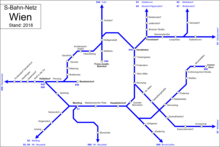



Vienna has an extensive transport system that includes roads, railways, trams, metro, and buses.






Vienna has an extensive transport system that includes roads, railways, trams, metro, and buses.
Vienna has a large public transport network.
Vienna has an extensive train and bus network. The convenience and flexibility of the public transport system is reflected by its popularity; 53% of Viennese workers travel to their workplace by public transport. [1] The overall modal split was 39% public transport and 27% private transport in 2016, compared to 29% and 40% respectively in 1993. [2]
Fares within the city cover all modes of public transport and are available for various time periods, such as for 24 hours, calendar weeks and calendar months. Tourist and yearly tickets are also available. Passengers must buy tickets prior to boarding or entering a station; however, on buses and trams, tickets can be bought or validated on board. There are no ticket barriers or inspections when entering public transit system, however transit inspectors - often in plainclothes - do conduct random ticket inspections on certain lines.
The Viennese public transport services are incorporated into a larger concentric system of transport zones, the VOR (Verkehrsverbund Ostregion = eastern region transport association). VOR includes railway and bus lines operating 50 kilometres (31 mi) into the surrounding areas, and ticket prices are calculated according to the number of zones crossed, Vienna being a single zone.

Vienna International Airport is located to the southeast of Vienna. The airport handled 22 million passengers in 2012. Following lengthy negotiations with surrounding communities, the airport will be expanded to increase its capacity by adding a third runway. The airport is currently undergoing a major expansion, including a new terminal building opened in 2012 to prepare for an expected increase in passengers. Another airport that's rather close to the city is Bratislava Airport in Slovakia. The airport is primarily used by low-cost airlines, such as Ryanair. It is a few kilometres away from the city, which means that Bratislava & Vienna shares each other's airports, due to the fact that both cities are not far away from each other.
Trains are operated by the ÖBB. Historically, all transport was oriented towards the main cities in the Austro-Hungarian monarchy. Vienna has two remaining train terminals that form the beginning of several train lines:
There are also several through train stations:
There are also a large number of smaller stations that are important for local passenger traffic. Since the mid-1990s, the Westbahnhof and Südbahnhof have handled all long-distance travel. Many trains also stop at Hütteldorf or Meidling, especially when inbound.
In order to bundle all long-distance traffic it has become necessary to build a tunnel, colloquially known as the Wildschweintunnel ("boar tunnel"), underneath Lainzer Tiergarten linking the Western Railway to the Southern Railway. The new bundled train line will connect to the new Wien Hauptbahnhof that is being constructed on the site of the previous Südbahnhof.

As in Austria generally, national highways are referred to as Bundesstrassen. Higher-capacity and higher-speed Bundesstrassen are further categorized into Autobahns and Schnellstrassen (expressways).
Five automobile bridges cross the Danube river within the city. From north to south, they are the Nordbrücke, Floridsdorfer Brücke, Brigittenauer Brücke, Reichsbrücke and Praterbrücke.
Five national autobahns leave Vienna in the westerly (A1), northwesterly (A22), northerly A5, easterly (A4), and southerly (A2) directions. Similarly to the rail lines, they are commonly referred to after their exit directions (Westautobahn, Südatobahn, Nordautobahn and Ostautobahn). In addition, several spur and branch autobahns circle around the southern and eastern areas of the city. Notably, the A23 Südosttangente connects the Süd Autobahn and Ostautobahn, and is the busiest road in Vienna. The protected Wienerwald forest area in the West and Northwest of the city has been left mostly untouched.
Schnellstraßen are similar to Autobahns except that they have slight inferiorities such as lower posted speeds and smaller curve radii. Within Vienna one may find the S 1 Wiener Außenring Schnellstraße and S 2 Wiener Nordrand Schnellstraße.
Similarly to the train lines, Bundesstraßen leave the city in a star-shaped pattern. Some are named after their historical final destinations; for example, Prager Straße to Prague, Linzer Straße to Linz, Triester Straße to Trieste and Brünner Straße to Brno (this last to be supplanted by the aforementioned A 5). Bundesstraßen can be compared to U.S. Highways in the United States, being two-lane in rural areas and multi-lane in urban areas.
Several European Routes pass through Vienna, including E 60, E 49, E 59, E 58 and E 461
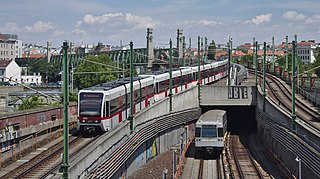
The Vienna U-Bahn, where U-Bahn is an abbreviation of the German word Untergrundbahn, is a rapid transit system serving Vienna, Austria. The five-line network consists of 83.1 kilometers (51.6 mi) of route, serving 109 stations. It is the backbone of what the International Association of Public Transport (UITP) deemed one of the best-performing public transport systems worldwide in 2009. 459.8 million passengers rode the U-Bahn in 2019. The network is undergoing expansion and rolling stock renewal. Since 1969, 200 million euros have been invested annually in the extension of the Vienna U-Bahn.
The districts of Vienna are the 23 named city sections of Vienna, Austria, which are numbered for easy reference. They were created from 1850 onwards, when the city area was enlarged by the inclusion of surrounding communities. Although they fill a similar role, Vienna's municipal districts are not administrative districts (Bezirke) as defined by the federal constitution; Vienna is a statutory city and as such is a single administrative district in its entirety.

Wiener Linien is the company running most of the public transit network in the city of Vienna, Austria. It is part of the city corporation Wiener Stadtwerke.

Wien Westbahnhof is a major Austrian railway station, the original starting point of the West railway (Westbahn) and a former terminus of international rail services. In 2015, its role changed with the opening of Vienna's new main station and Westbahnhof is now mainly a commuter station and the terminus of private rail operator WESTbahn's intercity service from Salzburg. Locally, Wien Westbahnhof is served by S-Bahn line S50 and U-Bahn lines U3 and U6. Six tram lines converge on Europaplatz in front of the station, although none go into the city centre. There are also buses to the airport.

The Vienna S-Bahn is a suburban commuter rail network in Vienna, Austria. As opposed to the city-run urban metro network, the Vienna U-Bahn, it extends beyond the borders of the city, is operated by the ÖBB, and consists of many branch lines. S-Bahn is short for Schnellbahn, which can be translated as "rapid railway".

Wien Praterstern is one of Vienna's main railway stations, used by 35,000 people daily. It is located on the roundabout Praterstern in Leopoldstadt, in the north of the city. Vienna's two most recognisable structures, the Wiener Riesenrad and the Stephansdom (cathedral), are both visible from the platforms. Underneath the station is the Praterstern U-Bahn station, which is on U1 and U2 of the Vienna U-Bahn.

The Vienna Stadtbahn was a rail-based public transportation system operated under this name from 1898 until 1989. Today, the Vienna U-Bahn lines U4 and U6 and the Vienna S-Bahn run on its former lines.

Wien Südbahnhof was Vienna's largest railway terminus. It closed in December 2009 and was demolished in 2010 to be replaced with a new station, Wien Hauptbahnhof. It was located in Favoriten, in the south-east of the city. The East-bound rail services of Südbahnhof remained in operation until 2012 at a temporary train station "Südbahnhof (Ostbahn)".

Wien Hauptbahnhof, Vienna Central Station or Vienna Main Station is the main railway station in Vienna, Austria, located in the Favoriten district. It became fully operational in December 2015, linking major railway lines from the north, east, south and west, and replacing the old Wien Südbahnhof terminus. With 268,000 daily commuters it is Austria's busiest long-distance railway station. Aside from being voted "Austria's most beautiful railway station", it was also second in Consumer Choice Center's ranking of "Top 10 Railway Stations for Passenger Convenience in Europe".

Wiener Neustadt Hauptbahnhof is a railway station in Wiener Neustadt, in the federal state of Lower Austria, south of Vienna. With over 700 trains and 25,000 passengers each day, the station is the busiest in Lower Austria.

The Southern Railway is a railway in Austria that runs from Vienna to Graz and the border with Slovenia at Spielfeld via Semmering and Bruck an der Mur. Along with the Spielfeld-Straß–Trieste railway, it forms part of the Austrian Southern Railway that connected Vienna with Trieste, the main seaport of the Austro-Hungarian Monarchy, via Ljubljana. A main obstacle in its construction was getting over the Semmering Pass over the Northern Limestone Alps. The twin-track, electrified section that runs through the current territory of Austria is owned and operated by Austrian Federal Railways (ÖBB) and is one of the major lines in the country.

Wien Meidling is one of Vienna's main railway stations located at the Philadelphiabrücke. When the Südbahnhof was demolished in December 2009 to build Vienna's new Hauptbahnhof, Wien Meidling assumed the functions of the Südbahnhof and has been in the 2020s frequented by 55,000 people daily, up from its usual 45,000, making it one of Austria's busiest railway stations.

Wien Mitte is a rail and U-Bahn station in Vienna, close to the city centre. It is the city terminus of Vienna's City Airport Train (CAT), which provides non-stop service to Vienna International Airport. The station is a major hub for S-Bahn suburban trains, with little service by InterCity trains. The station is connected to the Landstraße U-Bahn station.

Line U1 is a line on the Vienna U-Bahn metro system. Opened in 1978, it currently has 24 stations and a total length of 19.3 km (12.0 mi), from Oberlaa to Leopoldau. When the extension to Oberlaa was completed in 2017, the line became the longest on the network, surpassing the length of U6.
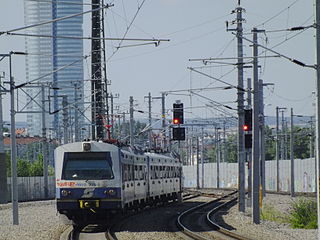
S1 of the Vienna S-Bahn is an electrified commuter rail service operating between Gänserndorf and Wien Meidling.
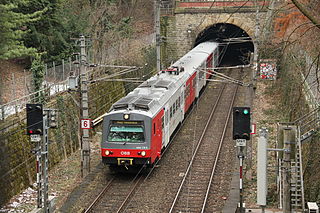
Line S45 of the Vienna S-Bahn, also known as the Vorortelinie(lit. Suburban Line) or Wiener Vorortelinie(lit. Vienna Suburban Line), is an electrified commuter rail service operating in Vienna, Austria.

Wien Hetzendorf is a Vienna S-Bahn station, served by S1 and S2. The station is 1.63 km (1.01 mi) west of Wien Meidling. The station is situated between Altmannsdorfer Straße and Hetzendorfer Straße. Connections are available to Lines 16A, 62A, 64A of Wiener Linien Bus service and Line 62 of Wiener Linien Tram service.

The following outline is provided as an overview of and topical guide to Vienna:
The Vienna semi-metro tramway system was built on separated sections in the 1960s. The underground sections are called Untergrundstrassenbahn or sometimes abbreviated U-Strassenbahn, USTRAB or USTRABA . The semi-metro tunnels are maintained and used by the Wiener Linien, operator of the tramway lines. One section is used as well by the Wiener Lokalbahnen (WLB), the operator of a regional tram-train service.
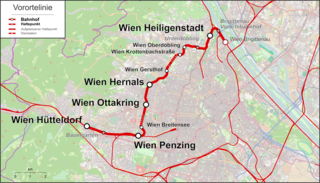
The Suburban line is a railway line in the city of Vienna. It runs approximately 14 kilometres (8.7 mi) from Wien Hütteldorf to Wien Heiligenstadt, running around the northwest side of the city. It hosts the S45 service of the Vienna S-Bahn.
![]() Media related to Transport in Vienna at Wikimedia Commons
Media related to Transport in Vienna at Wikimedia Commons